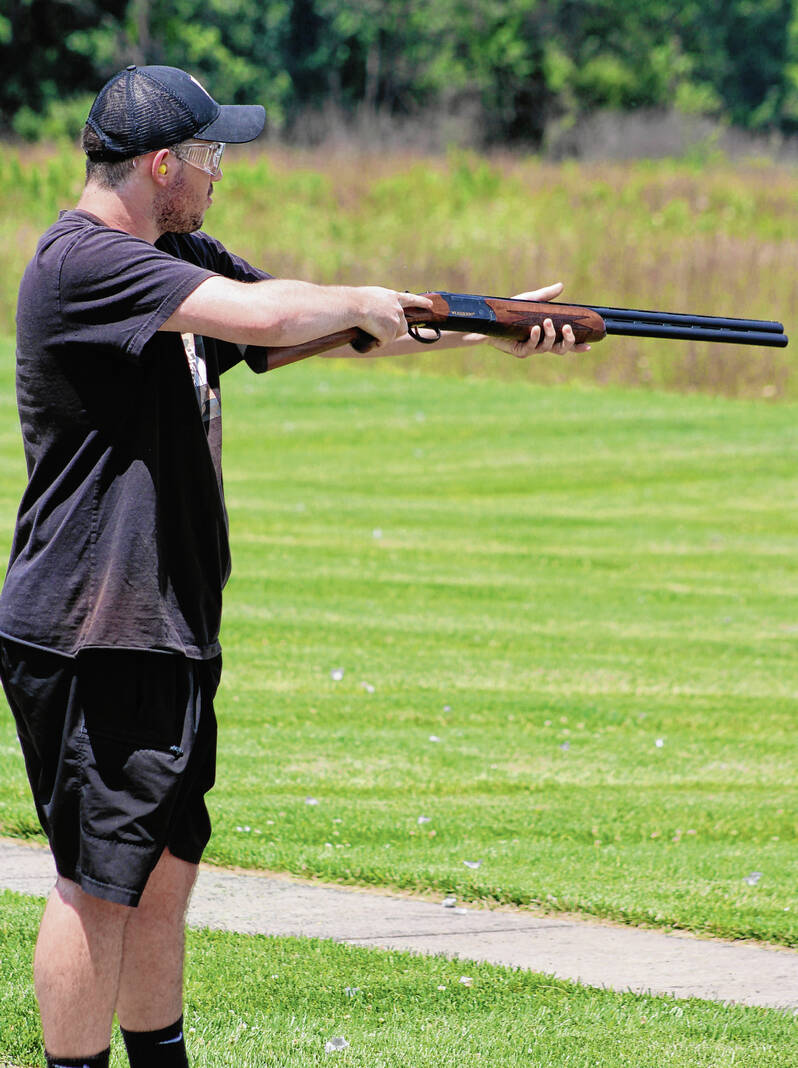
Adam Grbic tries out a shotgun at the Atterbury Fish and Wildlife Area during a recent waterfowl hunting education class.
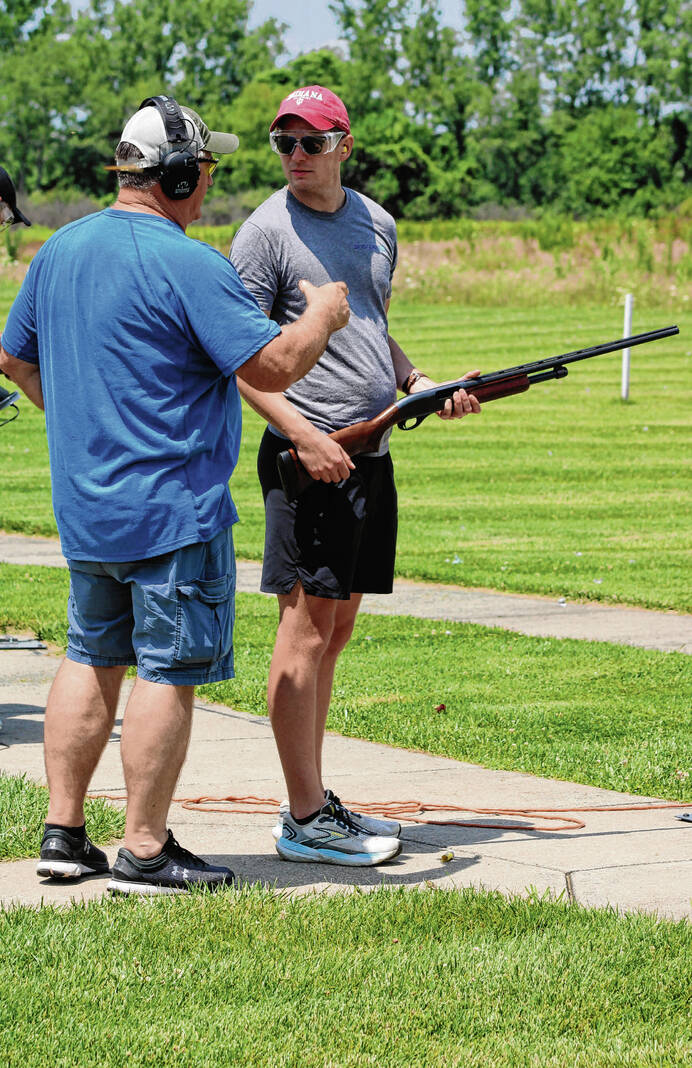
Justin Schneider receives some advice at the shooting range during a recent waterfowl hunting education class.
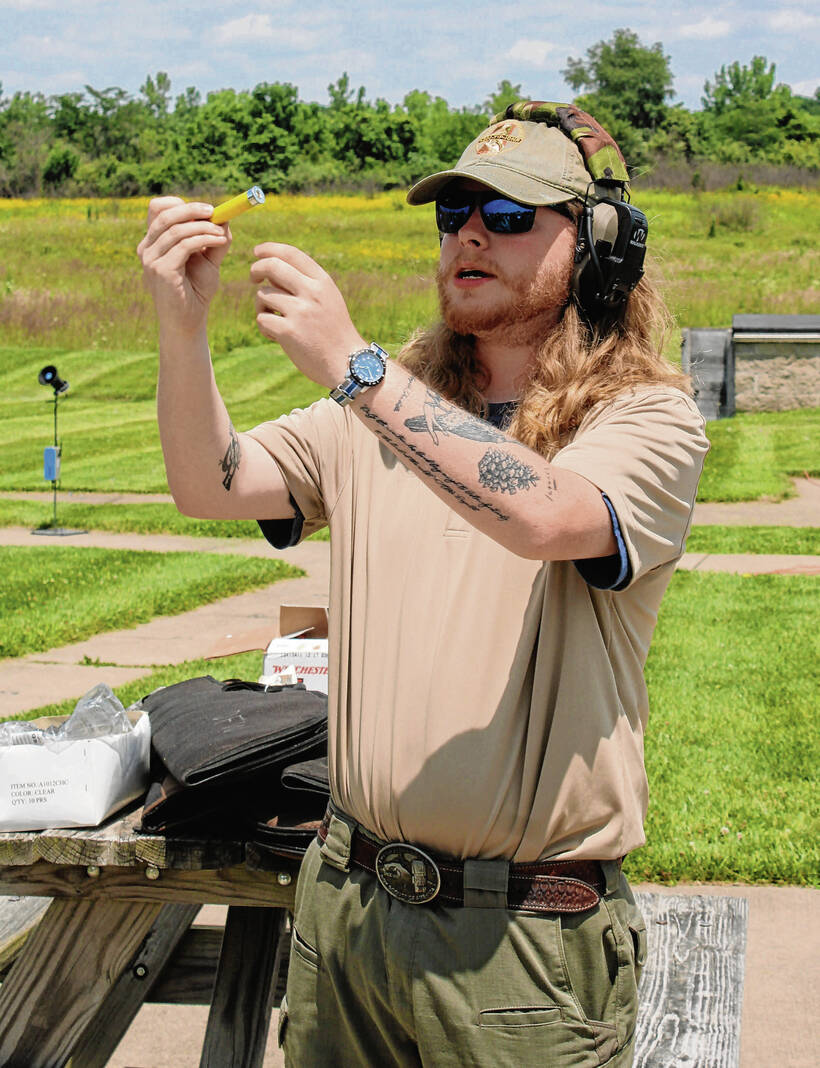
Branndon Castellano with the Indiana Department of Natural Resources shows students the shotgun shell they will be using when they practice their shooting during a Atterbury Fish and Wildlife Area sponsored class with Ducks Unlimited.
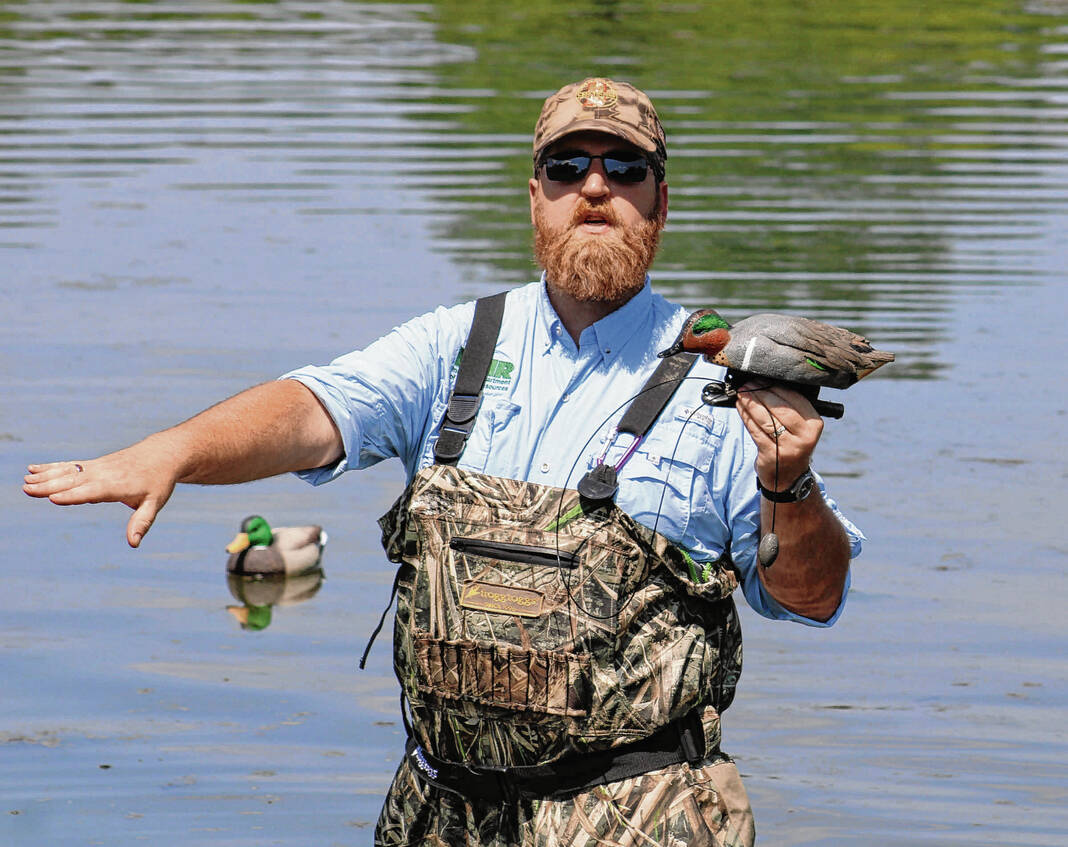
Jonathan Roales, assistant property manager at Atterbury Fish and Wildlife Area holds up duck decoys that definitely look like the real thing.
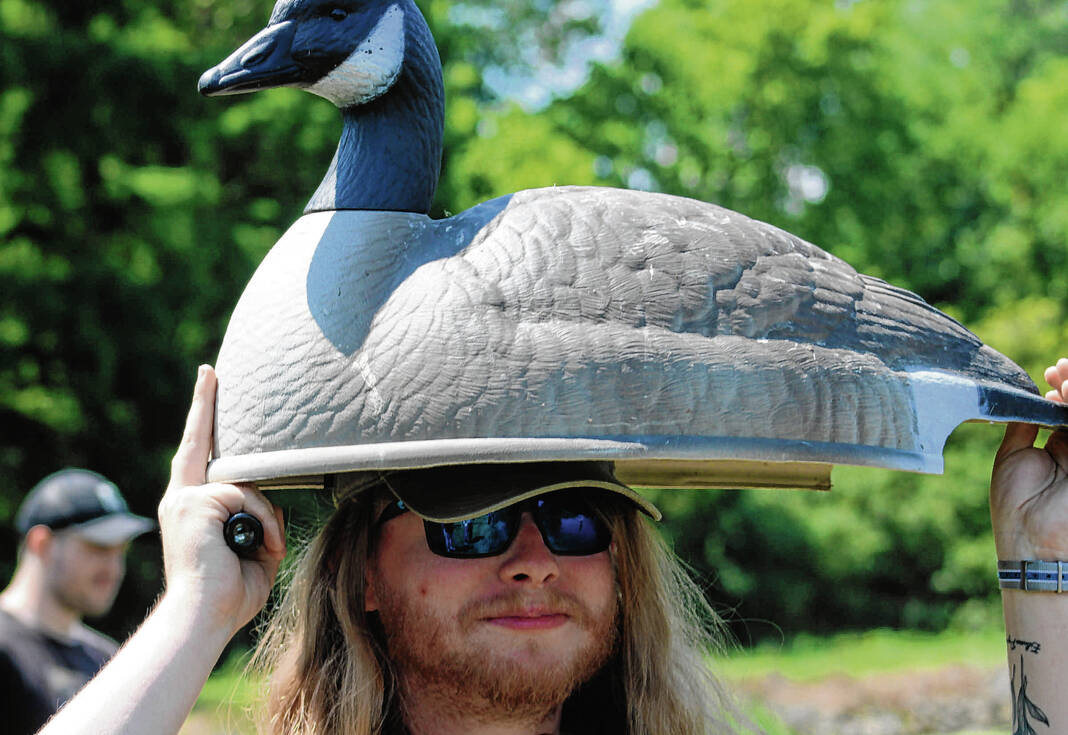
DNR’s Branndon Castello jokingly shows off how a goose decoy can help shield the sun.
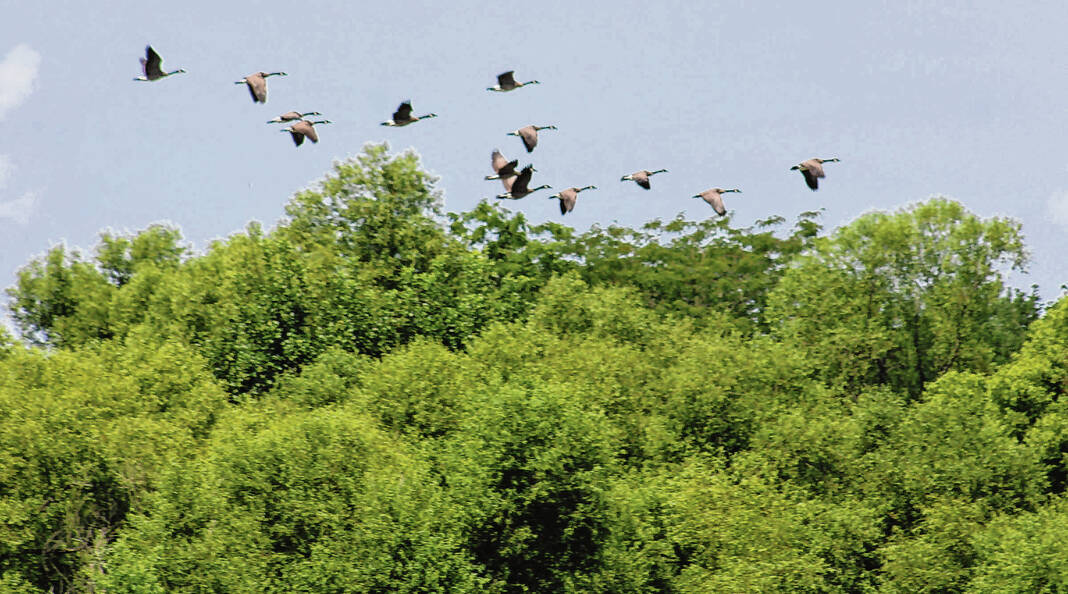
Waterfowl made a timely appearance above at Atterbury Fish and Wildlife Area for a waterfowl instructional course..
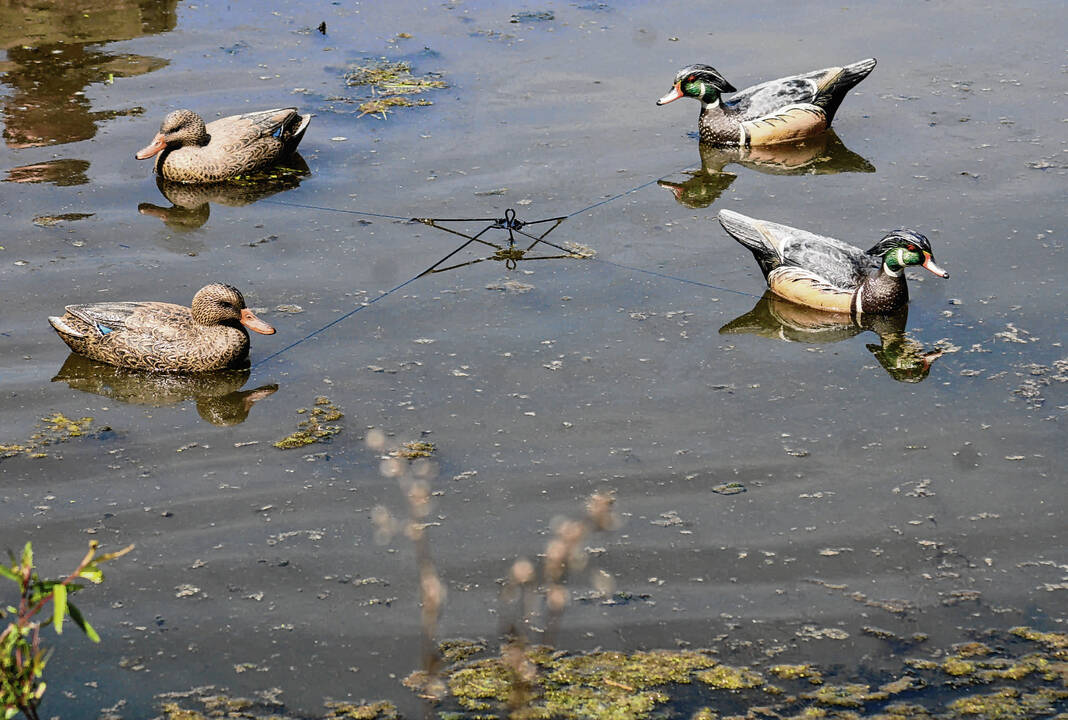
Looking like the real thing — as they are supposed to — are a gaggle of duck decoys.
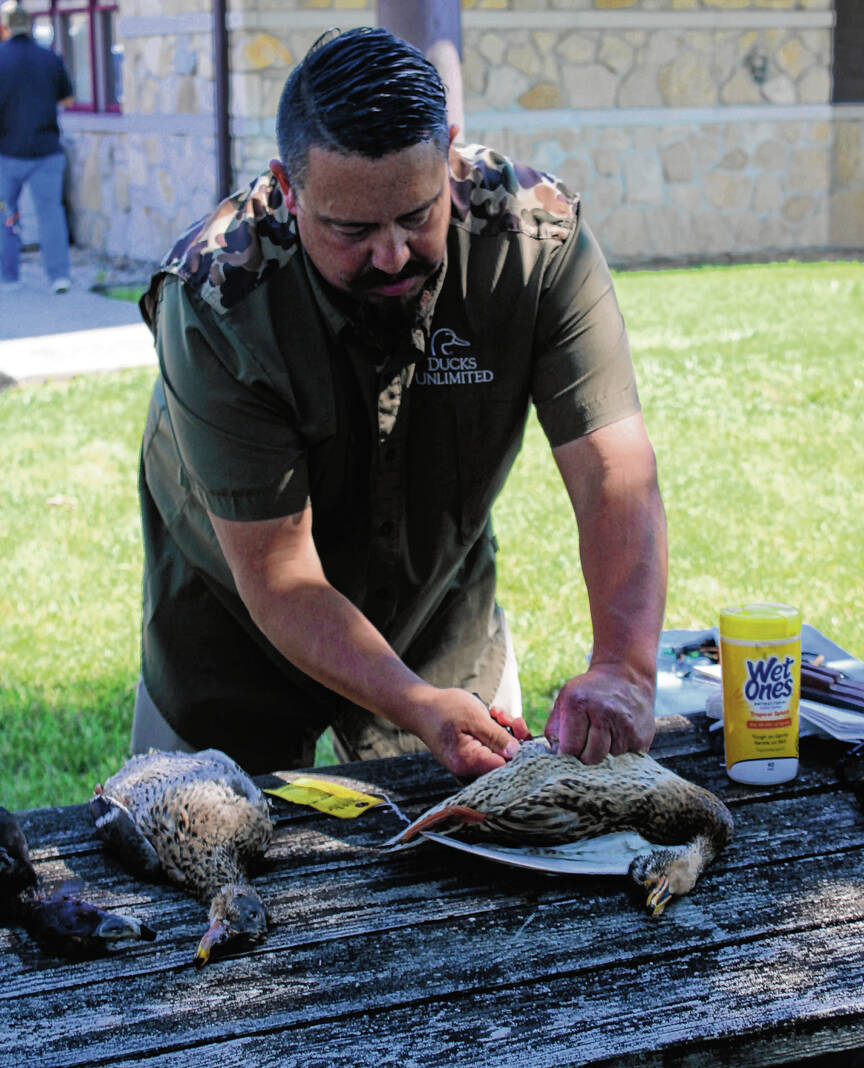
Dave Horvath shows how to field dress a duck.
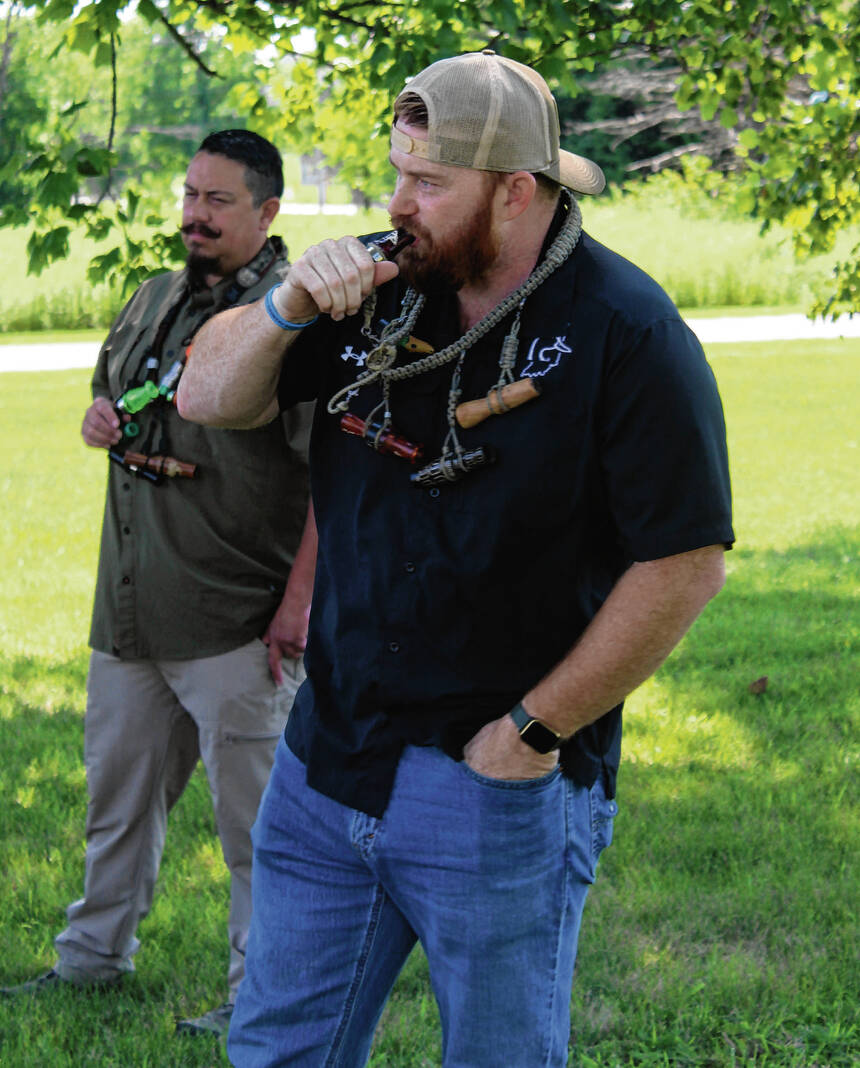
Jimmy Weddle of Ducks unlimited demonstrates proper duck and geese calling for waterfowl hunters.
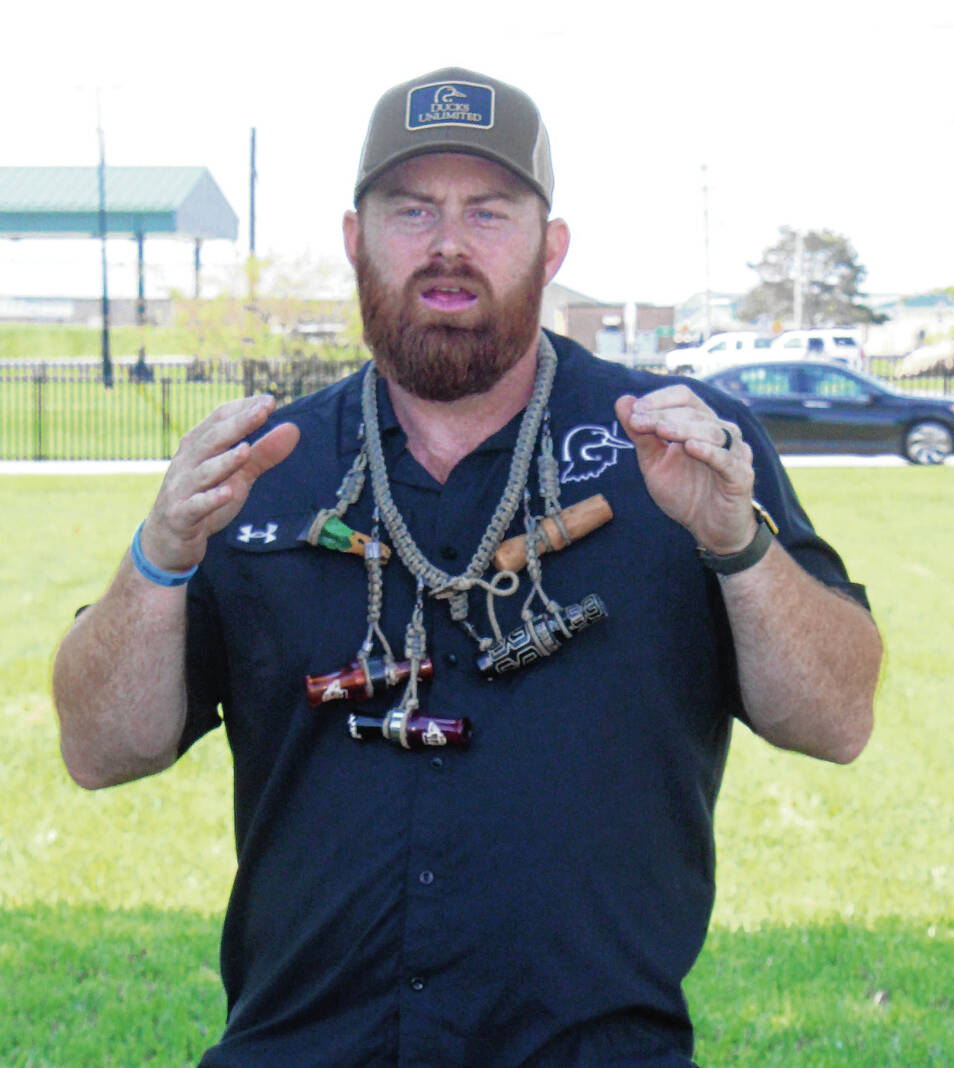
Jimmy Weddle has a call for every occasion around his neck.
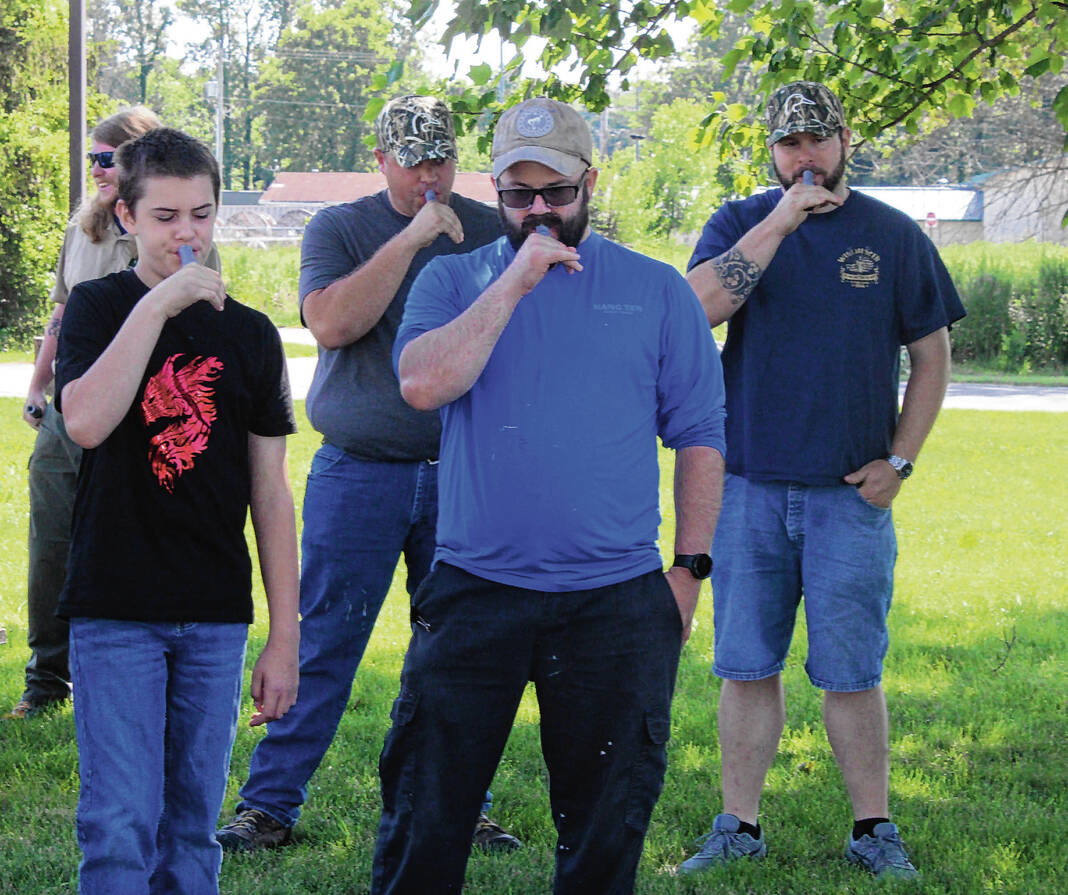
Several members of a DNR instructional course on waterfowl hunting practicing their calls.
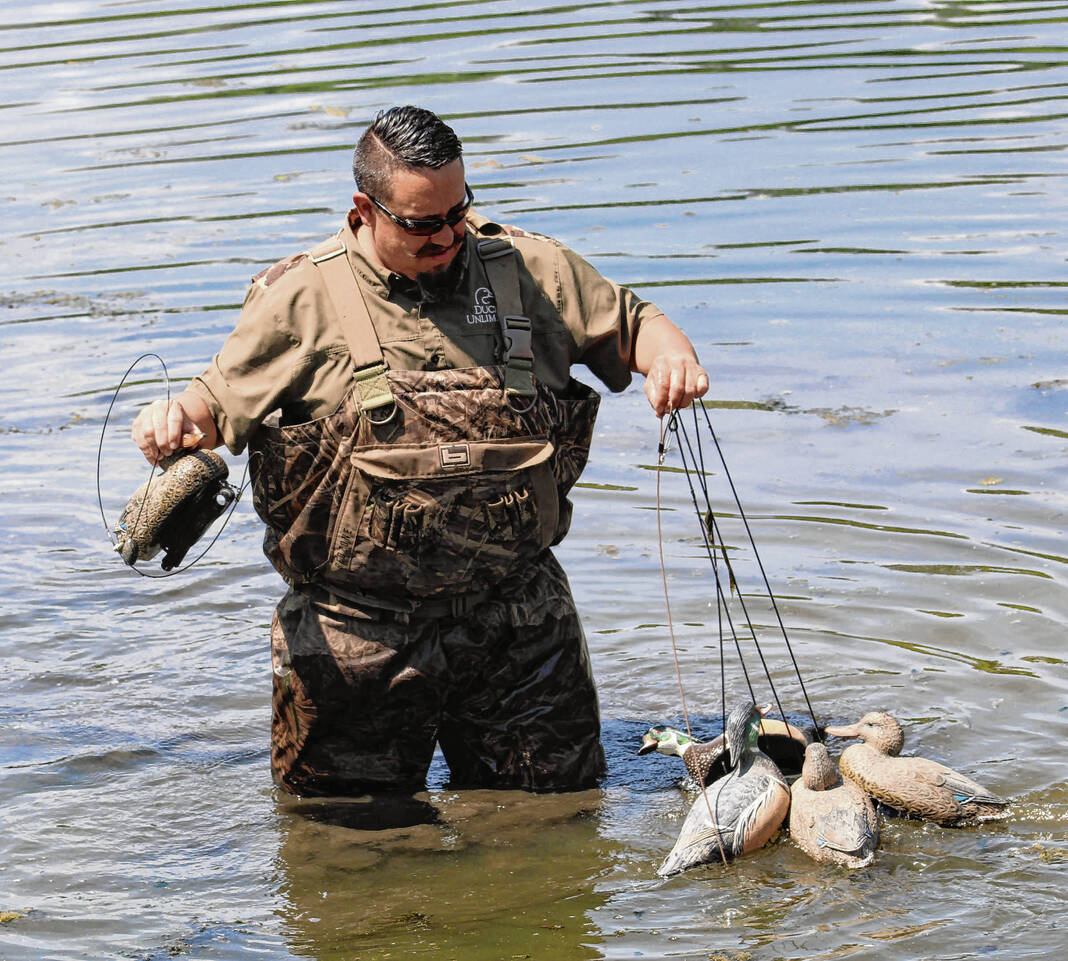
Dave Horvath of Ducks Unlimited wrangles duck decoys to help at a DNR waterfowl education course.
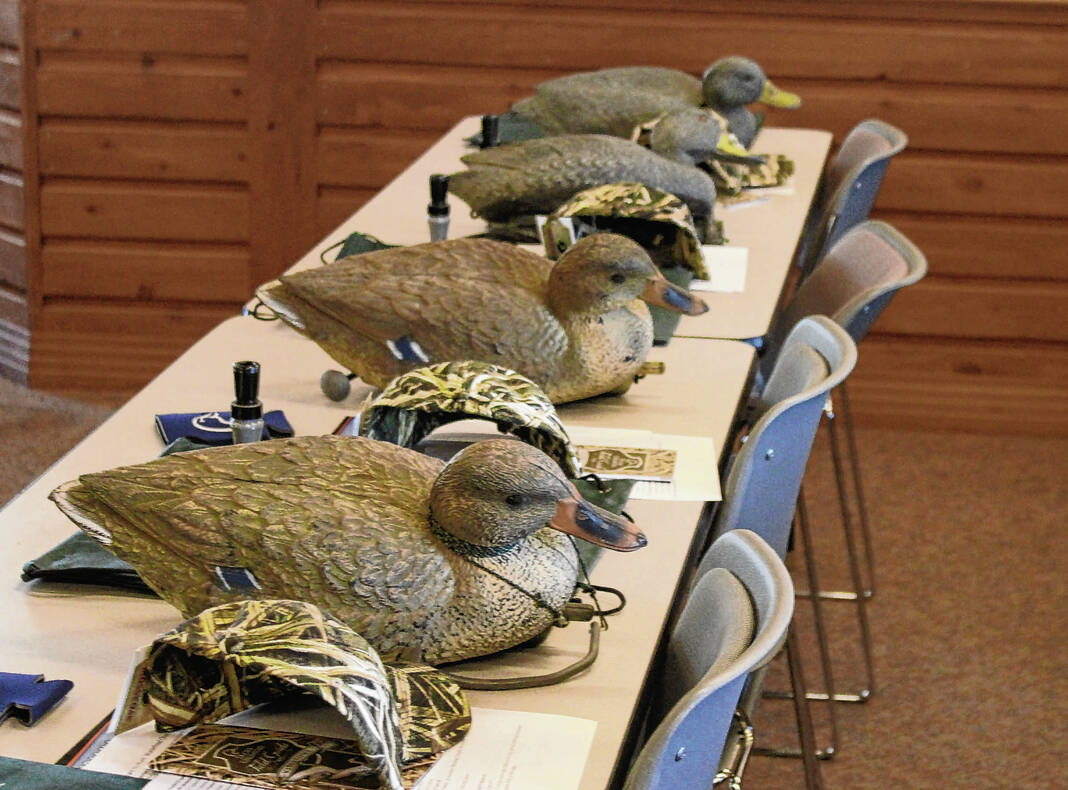
Decoy ducks given out to those attending an Indiana Department of Natural Resources’ recent waterfowl hunting class in Edinburgh.
EDINBURGH — At the risk of being labeled quacks, the group of eager callers inhaled, exhaled and sought to be duck imitators. Given that they were on dry land with no ponds or lakes in sight, it was no surprise no waterfowl swooped down from the sky to investigate.
Jimmy Weddle of Ducks Unlimited grasped one of the calls hanging on a lanyard around his neck and tooted while a dozen or more apt pupils watched and then did their best to follow in his lip-steps.
Learning how to speak duck, or speak goose, was par for a day of education that crammed about six hours’ worth of hunting learning into a recent Duck Hunting 101 seminar program at Atterbury Fish Wildlife Area.
“You don’t have to get super crazy with them,” Weddle said as he passed out free $10 calls to participants. “You’re supposed to use hot air from your diaphragm. If you’re not great, keep it simple.”
Or, one can be like Weddle and get serious. He has been known to practice his calling in his car while stuck in traffic.
The primer offered by the Indiana Department of Natural Resources and Ducks Unlimited seemed to cram an entire semester’s worth of knowledge into a single day.
There were even door prizes – everyone got to take home a souvenir decoy.
Hoosiers from around the region who signed up for the free class tended to have a background in hunting, but zero background in waterfowl hunting.
While deer and waterfowl pursuit may fall under the umbrella of hunting, Branndon Castellano, who coordinates outdoor education programs for DNR, said there are major differences between the disciplines.
“It’s drastically different,” Castellano said. “You’re shooting at the moving birds. They are very different skill sets. It’s a lot more of an art form.”
A wide variety of ducks pass through Indiana, most of migrating to a winter retreat to stay warm. These include mallards, green-winged teal, northern shoveler, wood duck, northern pintail, and more. The total state duck harvest for 2022 was approximately 68,800.
Although a small number of other species are harvested, the goose hunt, harvesting about 34,900 in 2022, was mostly Canada goose.
Those birds were taken by about 12,300 waterfowl hunters.
Instructors talked about all aspects of waterfowl hunting, with a field dressing demonstration, cooking on the premises and eating of ducks and geese. Wild game right on the patio. The taste-of-the-wild chunks were browned.
“A little bit more well done than I like,” said Jonathan Roales, the Atterbury assistant property manager, who led most discussions.
Roales could blame only himself for the slightly crispy meat – he was the cook.
Crash Course
Adam Grbic, 20, of Fishers was excited before he came and was more ready to pursue waterfowl after picking up pointers.
“I have hunted, but never waterfowl,” he said. “I started with squirrels. I graduated from squirrel hunting.”
And then moved on to rabbits and deer.
A cousin who waterfowl hunts piqued his interest and Grbic said he likes the idea of “the fast pace” of birds on the move.
If Grbic wishes to get started, he doesn’t have long to wait.
Goose and duck hunting seasons are split and can differ based on state-defined zones. Goose hunting early season for the South, Central and North zones is the same, Sept. 9-17. The second half of the South Zone season is Nov. 11-Feb. 11, 2025.
Duck season varies, but the first South Zone season is Nov. 11-12, with the second segment Dec. 2-Jan. 28, 2025.
Bag limits vary by species, but the maximum number of ducks allowed in possession is 18, with a daily harvest limit of six.
Roaleshad some assistance from others, but the 13 attendees were bombarded with information. This was no mandatory class, so merely by signing up, the wannabe waterfowl hunters (all but one male and only one young teen) had expressed interest.
Probably by mid-day they were itching to apply knowledge to a real hunt – which was just about the only thing not on the agenda.
Roaleswas a front man for the program, but not so long ago he was sitting in the cheap seats. A hunter for more than 30 years, since he was nine, Roalessaid he took the always-popular waterfowl course six years ago.
“People do like to learn new skills,” he said.
One reason why this DNR class strikes a chord, Roalessaid, is a change in how information gets passed on about the outdoors. Once, older generations led younger people into the woods and taught them, but that family-style pass-along isn’t happening as often.
“We’ve lost some knowledge over the years,” Roalessaid. Offering a class to the public makes it easy for DNR to encourage newcomers. “With a zero fee, it’s a pretty low barrier to sign up.”
Waterfowl can attract new people compared to other hunting, Roalessaid, is because it is not a solitary activity. A deer hunter might climb into a deer stand in a tree and sit alone for hours, but waterfowl hunters hang together, eat, drink and be merry.
“It’s a more social activity,” Roalessaid. Also, one might witness a bevy of sunrises and sunsets. “You get to see the beauty of the world.”
The continued beauty of the world – the earth – has much to do with the connection of Ducks Unlimited to this program. As a co-sponsor, Ducks Unlimited not only sprang a goody bag, plus the decoys, all leftovers in storage.
Ducks Unlimited is a conservation organization but does not oppose hunting. Weddle, the DU district chair, is an avid hunter, who uses those calls.
DNR, hunters and DU have the same broader goal in common than a daily bag limit of waterfowl. Weddle said 85 percent of the money Ducks Unlimited raises goes back into land. The group wants to preserve clean water for any purpose.
“We don’t care if you hunt or bird watch,” he said. “Our biggest thing is to put our funds into the ground.”
The “ground” being wetlands, preserving them, salvaging them, making sure they last for this generation’s grandchildren.
Gun safety paramount
No one shoots at a running deer, but everyone shoots at flying ducks and geese.
That is one fundamental difference between the types of hunting. When any DNR course is given to the public involving guns, serious stress is placed on how to handle, load, and transport the proper guns needed.
“Safety, safety,” said Robles.
That is a universal theme, but other aspects of waterfowl hunting require a different mindset from hunting land mammals. A few are: No baiting, such as using corn; no hunting under sail, though Roalessaid he has never seen anyone hunt birds from a sailboat); no using pistols or rifles, only specific gauges of shotguns.
Being able to identify a species flying overhead is critically important so a violation can be avoided.
“It’s always better to not pull the trigger if you don’t know what you’re doing,” Roalessaid.
Words to live by when using any firearm.
Decoys fool ducks
The 5,400-acre Atterbury Fish Wildlife Area is across the street from Camp Atterbury and used to be part of the military facility. Outdoors visitors still pass barbed wire fences, but can retreat into wooded areas for hunting, fishing, wildlife watching, access to a gun range and archery range and more.
Appropriately, there are wetlands, such as Mallard Marsh, named for everyone’s favorite ducks, Possum Puddle, Mink Meadow Marsh and Honker Haven.
Dressing in camo, Roalesled students from the classroom and waded into Honker Haven, and with the aid similarly clad Dave Horvath of Ducks Unlimited, spread around some artistic looking duck decoys.
From 20 feet, the decoys looked real, which is their job, since they are designed to fool flying-by live ducks into cozying up.
Hunters have employed decoys for thousands of years. Originally, decoys were all made from wood. Over time they became appreciated pieces of art and began selling for high prices. Subsequently, lighter weight decoys made of plastic were manufactured.
In 2007, proof of how meticulously made hand-carved decoys had become objects d’art. two decoys were sold for more than $1 million each. Those given away in the class could be compared to mass-produced poster or print art versus an original oil painting.
Roalesand Horvath spread around 10 duck decoys, showing off a notable spread for a hunt. If success is sought, some practical measures must be taken.
“You can talk and you can smell bad,” Weddle said, “but you don’t want to be seen.”
Almost on cue for demo purposes, a flock of geese rose from trees across the marsh and flew past in a V formation. They were out of season.
Learning shotgun shooting
Shotguns were handed out for use at the shooting range, where trap shooting mimics bird hunting. For these waterfowl novices, soaking in the basics was required.
If the orange sporting clays were ducks or geese almost all of them would have lived to fly another day. Grbic said the opportunity was great, but he will need more practice.
“How cool is it that they provide the ammo and the guns and let people shoot,” he said. “I’m gonna need some range time if I’m going for ducks.”
Justin Schneider sought as much advice as he could obtain on the range.
“I’ve only been hunting for seven years,” he said, listing deer, turkey and rabbit as previous targets. “This (waterfowl) just seemed like a logical next step.”
After the in-depth course instruction, Schneider felt ready to give it a try – as long as the geese and ducks didn’t fly too fast.
